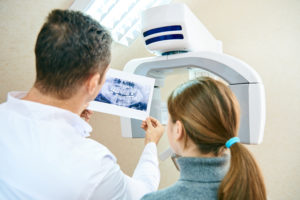Why Does Your Dentist Take X-Rays of Your Mouth?
August 11, 2022

When you visit your dentist for a routine checkup, they always carefully examine your mouth and perform a professional cleaning to remove hardened tartar. However, you may have also noticed that your dentist recommends taking dental X-rays every year or so. Why is this a necessary part of your visit? How do you benefit? Keep reading to find out!
Why Are Dental X-Rays Performed?
X-rays use low levels of radiation to capture images of the interior of your teeth and gums. Skin and other tissues do not easily absorb radiation. However, both teeth and bones do, which means they show up clearly in X-rays. By allowing your dentist to see much more than what they could with their naked eye, X-rays help identify emerging oral health problems. Dentists often rely on X-ray technology to help diagnose tooth decay, bone loss, impacted teeth, and many other health issues.
The Types of Dental X-Rays
Three of the most common types of dental X-rays include:
- Bitewing – Bitewing X-rays help dentists locate early signs of decay between back teeth or teeth in front of the molars.
- Periapical – These X-rays focus on just one or two teeth at a time.
- Panoramic – As the name suggests, panoramic X-rays show the entire mouth in one image. This type of X-ray can help identify issues like cysts, jaw disorders, or bone irregularities.
Are Dental X-Rays Safe?
Modern X-ray machines are designed to minimize radiation and are considered safe by the American Dental Association. As an added precaution, your dentist may place a leaded apron over your chest, abdomen, and pelvic region before taking X-rays. This will help to prevent any unnecessary radiation exposure to your vital organs. A special leaded collar may be placed around the neck of patients with thyroid conditions.
There is an important exception: women who are pregnant or believe they may be pregnant should avoid all types of X-rays. If you know or believe you may be pregnant, just be sure to let your dentist know ahead of your next appointment.
What Are the Advantages of Digital X-Rays?
Like many other forms of technology, X-rays have advanced considerably over the past several decades. Many dentists are now adopting new digital X-ray technology due to its impressive advantages. Compared to traditional dental X-rays, digital X-rays emit 90% less radiation, produce higher quality images, and take only a fraction of the time to develop. Digital X-rays can also be easily stored on computers so your dentist can refer back to them whenever necessary.
While exams and cleanings are important components of dental checkups, dental X-rays are also a valuable tool to prevent cavities, infections, and other oral health issues from developing into major trouble.
About the Author
Dr. Steven Oshins is dedicated to providing his patients with the most effective, up-to-date, and proven dental treatments. The proud University at Buffalo School of Dental Medicine graduate uses digital X-rays to identify emerging dental issues and monitor long-term changes in patients’ oral structures. To learn more about the benefits of dental X-ray technology, visit the Oshins of Smiles website or call 518-356-5635.
No Comments
No comments yet.
RSS feed for comments on this post.
Sorry, the comment form is closed at this time.

